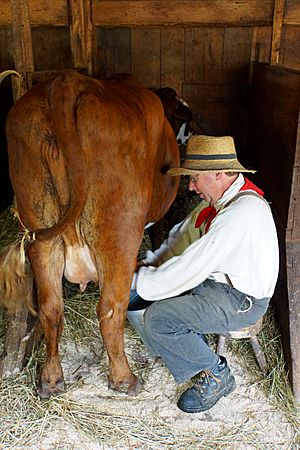Ross Farm Museum facts for kids
 |
|
| Location | New Ross, Nova Scotia, Canada |
|---|---|
| Type | agricultural museum |
The Ross Farm Museum is a special place in New Ross, Nova Scotia. It is an agricultural museum, which means it shows what farm life was like a long time ago. You can find it in Nova Scotia, Canada. It is about an hour's drive from the city of Halifax.
Contents
What to See at Ross Farm
The Ross Farm Museum helps visitors understand Nova Scotia's farming past. It shows how people lived and worked on farms many years ago.
Exploring the Farm
When you visit, you can see many interesting things. There are people dressed in old-fashioned clothes. They show how artisans, like blacksmiths, used to work. You can also see live farm animals. The museum has old buildings and tools from the past.
Inside the Village
The museum has a country store. It shows the kinds of products people bought back then. There is also a cooper shop. This is where people made wooden barrels. You can see different kinds of farm animals that were common long ago. A blacksmith works at the forge, shaping metal. There is even a village school house to explore.
Fun Activities
Guides in costumes are ready to explain what life was like. They can tell you about daily chores and how things were done. Sometimes, you can even enjoy a wagon ride around the farm. The Ross Farm is part of the Nova Scotia Museum network.
History of Ross Farm
The Ross Farm and the village of New Ross have a long history. They were started by a man named William Ross.
William Ross's Journey
William Ross was born in Cork, Ireland. He was a soldier in the British Army. He traveled to many places, including Surinam. His wife, Mary, was with him. They had children while traveling. They even survived two shipwrecks! One was off the coast of Ireland. The other was near Nova Scotia.
Settling in Nova Scotia
After his time as a soldier, William Ross came to Halifax. He and his family were helped by a man named John Lawson. William Ross later named a lake near his new home Lawson Lake, to thank him. In 1816, William Ross led many former soldiers to new land. This land was along a road between Chester and Kentville, Nova Scotia. This is how the village of Sherbrook, later called New Ross, began. William Ross died in 1822 when he was 39 years old.
Edward Ross's Diaries
William's son, Edward Ross, kept diaries for most of his life. These diaries are very important. The Ross Farm Museum is based on what Edward wrote. He wrote about his life on the farm when he was a young man, from 1835 to 1841.
Edward sold farm products from his store. He also traveled by boat to Halifax every spring. He was a justice of the peace, which meant he helped with local laws. Edward later moved away and got married. He lived until he was 81 years old. He spent his last few years back on the Ross Farm.
Museum Connections
The Ross Farm Museum is connected to several important groups. These connections help the museum share its history.
- Canadian Museums Association (CMA)
- Canadian Heritage Information Network (CHIN)
- The Association for Living History, Farm and Agricultural Museums (ALHFAM)
- Virtual Museum of Canada
See also

